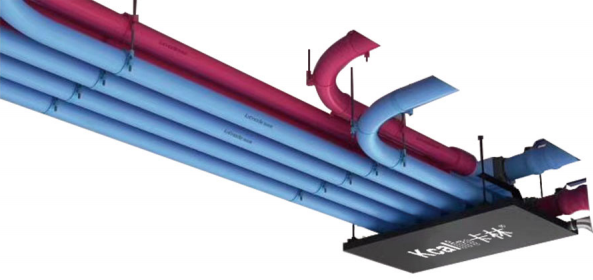With the continuous evolution of modern architecture and safety standards, air quality and fire safety management issues within buildings become particularly important. In this context, smoke control and ventilation systems have become key building elements, but they may have different functional operating principles.
1: Smoke control and exhaust system
Definition of smoke exhaust system: A smoke exhaust system is a system used for fire safety management, whose main function is to control smoke and harmful gases during a fire, providing safe evacuation routes and preventing smoke from spreading to other parts of the building.
Working principle: Smoke control and exhaust systems usually include smoke exhaust fans, smoke exhaust channels, and control systems. When a fire breaks out, the system uses smoke exhaust fans to exhaust smoke from the fire source area, while maintaining a relatively clean escape channel. This helps to provide more time for personnel evacuation and reduce the threat of harmful gases to life and property.
The main functions include: ① controlling smoke diffusion and maintaining the smoothness of escape routes. ② Reduce the concentration of harmful gases and provide more breathing space Assist firefighters in locating the source of fire and carrying out firefighting work. ④ Provide evacuation routes to ensure that people inside the building can quickly and safely leave.
2: Ventilation system

Definition of Ventilation System: A ventilation system is a system used to improve the internal air quality of a building. Its main function is to introduce fresh air into the room and exhaust exhaust gases to maintain a comfortable indoor environment.
Working principle: The ventilation system includes air supply and exhaust systems, usually including filters and temperature control. Fresh air is introduced through the air supply system, while exhaust gas is discharged through the exhaust system. Filters can remove pollutants from the air, while temperature control ensures a suitable indoor temperature.
The main functions include: ① providing fresh air and improving indoor air quality. ② Adjust indoor temperature to ensure comfort. ③ Remove pollutants such as harmful gases, particulate matter, and odors. ④ Avoid indoor humidity and reduce the risk of mold and bacterial growth.
3: Key differences
Purpose and focus: The main purpose of smoke control and exhaust systems is to control smoke and harmful gases in the event of a fire, ensuring the safety of personnel. The main purpose of the ventilation system is to provide a comfortable indoor environment, improve air quality and temperature.
Operating conditions: The smoke exhaust system is usually activated during a fire, and it is passive and only operates in emergency situations. The ventilation system can continue to operate during normal use of the building to maintain the quality of the indoor environment.
Equipment and control: The smoke exhaust system uses smoke exhaust fans and smoke exhaust channels, and its control is triggered by fire detectors. The ventilation system uses air handling equipment such as fans, filters, and temperature control equipment, and its operation is affected by timers or indoor temperature/humidity control.
Indoor air quality: The goal of smoke control and exhaust systems is to control smoke and harmful gases, without necessarily improving indoor air quality. The goal of the ventilation system is to provide fresh air to improve indoor air quality.
Smoke control and ventilation systems play important roles in building safety and indoor comfort, but they have different purposes and functions. Understanding the key differences between these two is crucial for ensuring safety and comfort within buildings. In actual design and maintenance, architects, engineers, and building administrators must fully consider these two systems to meet their respective needs and requirements. The smoke exhaust system ensures life safety, while the ventilation system provides the quality of the indoor environment. Together, they play an indispensable role in building a safe and comfortable building.







Comment